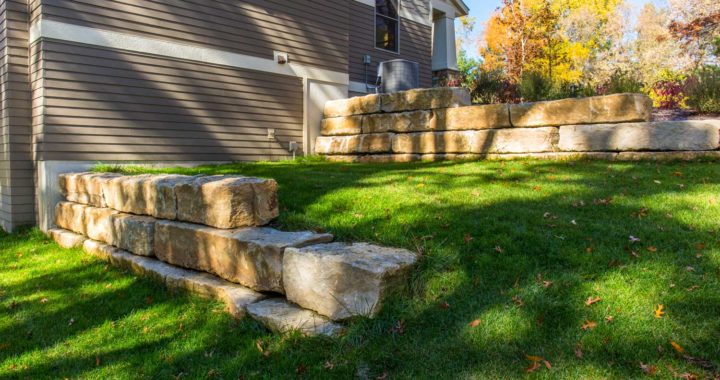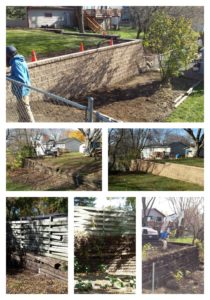Many of our projects include the creation of pleasurable entertaining spaces and design of stunning curb appeal. But just as important, are those nitty-gritty projects that focus on function and structure.
Retaining walls are a functional and eye-catching answer to an unstable or sloped yard. They not only help to prevent soil erosion, retaining walls also create usable areas such as patios, sidewalks, and driveways.
But what should you do when an existing retaining wall has lost its original splendor and safety is an issue?
Michelle, a Cottage Grove homeowner, had a railroad tie retaining wall that was over 30 years old and in need of replacement. As can be seen in the pictures, ties were rotting away, and the existing privacy fence was ready to fall. Erosion was also becoming a problem.
Due to the size of the project, multiple steps needed to be followed in the planning phase.
Before starting construction, we needed to first obtain a City permit. One of the permit requirements included undergoing a site survey to locate property lines. We then had to take detailed area measurements to a civil engineer for the creation of an engineering plan.
With the permit in hand, the McDonough Landscaping crew could start demolition of the retaining wall and fence. Multiple loads of railroad ties and construction debris were hauled away just to prepare for excavation.
While installation of a well-built retaining wall may not look that difficult, the result of poor design is frustrating and expensive. Water has the potential of weakening retaining walls by washing out supporting base material. It can also soak the soil behind the wall and applying incredible pressure. This pressure then forces retaining wall materials to lean, bulge, and eventually collapse.
It’s important to use the correct soils and materials to aid in the drainage of water.
With Michelle’s project, about 200 yards of soil were removed to make room for the new construction. We then used 50,000 pounds of Class 5 base material; 100,000 pounds of drainage rock; and 40 yards of sand backfill. Due to the wall’s height, the installation also included multiple layers of Geosynthetic Reinforcement to stabilize the soil. Construction of the 130-foot wall (with the tallest point being 8 feet) involved over 55,000 pounds of concrete retaining wall block.
With the retaining wall safe and secure, the McDonough crew finished grading the yard and installing sod. The finishing touches included landscape edging and mulch to create new planting beds.
How long did this complex project take?
The most time-intensive phase of the project was in the planning. It took six weeks to create the initial estimates and to obtain the survey, engineering plans, and permit approval. But after the conclusion of all of the paperwork and planning, retaining wall installation and landscaping clean-up took only six and one half days.
If I was to describe McDonough Landscaping with one word, it would be professional. I was a bit nervous because of the size and scope of the retaining wall project in my back yard. Matt assured me that his company had the experience and knowledge needed to get the job done right. The project was constructed on time, under budget, and it looks beautiful!
I would highly recommend McDonough Landscaping to anyone.
Michelle
Are you in need of a new retaining wall? We have the skills and expertise required to help you through the process. Contact us today for a free consultation. 651.755.7901

